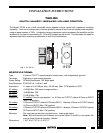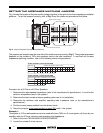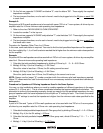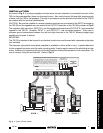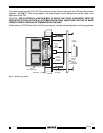
3
Speakers & Volume Controls
760-00
3. On the 3rd row, opposite "8 OHMS" and below "3", note the letters "S8". These signify the required
impedance multiplier.
4. The two jumpers therefore, one for each channel, need to be plugged onto the
S8 pins on each 760
in each room.
Example 2:
Seven pairs of 8 Ohm wall speakers are to be used with seven 760's in a 7-room system, all driven by one
amplifier rated for 4 Ohms minimum safe operating load impedance.
1. Refer to the chart "WHEN USING 8 OHM SPEAKERS".
2. Locate the number 7 in the top row.
3. On the next row, opposite "4 OHMS" and just below "7", note the letters "S4". These signify the required
impedance multiplier.
4. The two jumpers therefore, one for each channel, need to be plugged onto the
S4 pins on each 760
that feeds each room.
Procedure for Speakers Other Than 4 or 8 Ohms:
In this case, some calculation is required. You need to find the total paralleled impedance of the speakers
first, then multiply it by 1, 4, or 8 until a value is reached that is higher than the minimum safe value specified
for the amplifier.
Example:
Six pairs of 5 Ohm wall speakers are to be used with six 760's in a 6-room system, all driven by one amplifier
rated for 4 Ohms minimum safe operating load impedance.
1. Calculate the total paralleled impedance by dividing 5 Ohms by 6. 5 ÷ 6 = 0.83 Ohms.
2. Multiply 0.83 by 4 (for the S4 setting) = 3.32 Ohms.
Since this value is less than 4 Ohms, the S4 setting cannot be used.
3. Multiply 0.83 by 8 (for the S8 setting) = 6.64 Ohms.
Since this yields more than 4 Ohms, the S8 setting is the correct one to use.
NOTE: Always use the lowest "S" number consistent with the minimum safe load impedance required.
Higher "S" values would be "safe" but would result in an unnecessary reduction in power level delivered to
each speaker.
Procedure for Speakers of Differing Impedance Used in the Same System
You may run into installations where you need to combine speakers of different impedance in the same
system (8, 6, 4 Ohms, etc.). This is a more complicated situation that requires additional calculation. The
procedure is similar to the preceding example, except you need to find the paralleled impedance for each
group of speakers with the same impedance first and pick an "S" setting for each. Then check the overall
paralleled "S" settings to see that the impedance is higher than the minimum safe value specified for the
amplifier.
Example 1:
2 pairs of 4 Ohm and 7 pairs of 8 Ohm wall speakers are to be used with nine 760's in a 9-room system,
all driven by one amplifier rated for 4 Ohms min. safe operating load impedance.
1. Calculate the total paralleled impedance of 4 Ohm group first, by dividing 4 Ohms by 2. 4 ÷ 2 = 2 Ohms.
2. Multiply 2 by 4 (for the S4 setting) =
8 Ohms.
3. Calculate the total paralleled impedance of 8 Ohm group next, divide 8 Ohms by 7. 8 ÷ 7 = 1.14
Ohms.
4. Multiply 1.14 by 8 (for the S8 setting) =
9.12 Ohms.



